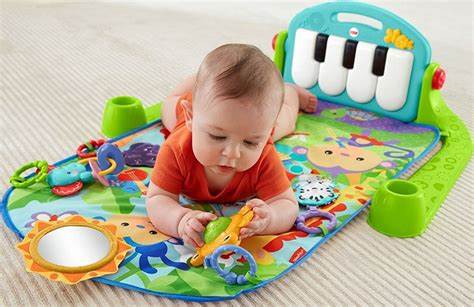Choosing toys for a baby can sometimes feel a bit overwhelming with all the options out there. But picking the right toys—those that match their age and development—matters a lot. The right toy isn’t just fun; it can help stimulate their senses and encourage important skills. This guide breaks down what to look for at different stages during a baby’s first year.
- Prioritize Safety Above All Else
First and foremost, safety is key. Babies tend to explore by putting things in their mouths, so small parts can quickly become a choking hazard.
- Choking Hazards: A simple rule is that if a part fits entirely inside a toilet paper roll, it’s too small for babies under three. Avoid toys with little detachable pieces like beads or buttons.
- Sturdy Construction: Look for toys that are well-made, without sharp edges or parts that could easily break off.
- Safe Materials: Choose toys made from non-toxic materials like BPA-free plastics, untreated wood, or organic fabrics. If a toy smells chemical-y, it’s better to skip it.
- Cords and Strings: Avoid toys with cords or strings longer than 12 inches (about 30 cm) to reduce strangulation risks.
- Battery Safety: If a toy uses batteries, make sure the compartment is screw-secured and can’t be easily opened.
- Labels and Certifications: Always check the recommended age on packaging—they’re based on safety, not just skill level. Look for safety marks like ASTM F963 (U.S.) or EN71 (Europe).
- Supervise: Even the safest toys need supervision. Never leave a baby alone during play.
- Understand Baby Developmental Stages
Babies change fast. What’s right for a newborn won’t work for a 9-month-old, so match toys to their stage.
0-3 Months: Newborn Exploration
At this early stage, babies are mainly tuning into their senses.
- High-contrast toys in black, white, or red catch their still-developing eyes.
- Soft rattles or gentle musical toys stimulate hearing.
- Mobiles (kept out of reach) help with visual tracking.
- Unbreakable mirrors and textured mats make tummy time more interesting.
- Lightweight, soft toys encourage grasping practice.
3-6 Months: Reaching and Grasping
Babies begin reaching out and exploring cause and effect.
- Teething rings with different textures soothe sore gums.
- Activity gyms and play mats offer hanging toys for batting and kicking.
- Sensory balls invite rolling and holding.
- Soft books with crinkly pages introduce early textures and sounds.
- Linkable rings develop fine motor skills.
- Simple rattles remain favorites.
6-9 Months: Sitting, Crawling, Object Permanence
Mobility grows and babies start realizing things exist even when out of sight.
- Stacking cups or rings promote problem-solving.
- Soft blocks are great for building and knocking down (which is all part of learning).
- Cause-and-effect toys that light up or make noise fascinate.
- O-balls are easy to grasp and roll.
- Activity cubes invite exploration.
- Soft rollers encourage movement and reach.
9-12 Months: Cruising, Exploring, Problem-Solving
Babies are pulling up, cruising around, and getting more curious.
- Push and pull toys support walking skills.
- Shape sorters teach hand-eye coordination.
- Nesting toys develop spatial reasoning.
- Board books with clear images support early language.
- Toy phones or remotes let babies imitate grown-ups.
- Large pegboards help with matching and fine motor control.
- Look for Engaging Features
Beyond age and safety, what makes a toy captivating?
- Sensory Stimulation: Toys that appeal to sight, sound, and touch—bright colors, varied textures, gentle sounds—tend to hold attention better.
- Open-Ended Play: Toys like blocks or stacking cups that can be used in different ways encourage creativity as your baby grows.
- Durability: Babies aren’t gentle. Pick toys that can handle chewing, dropping, and tugging.
- Easy to Clean: Since toys will get dirty, look for ones you can wipe down or wash without hassle.
- Purposeful Design: The best toys don’t just entertain; they support skill-building, whether that’s fine motor, gross motor, cognitive, or sensory development.
- Consider Practicality and Quantity
More toys don’t always mean better play.
- Less Is More: Too many toys can overwhelm and distract a baby. A few thoughtfully chosen, quality toys often do more good.
- Rotation: Try rotating toys. Put some away and bring them back later to keep interest fresh without constantly buying new stuff.
- Storage: Think about where you’ll keep the toys and how easy it is to tidy up afterward.
- Versatility: Some toys grow with your baby, offering different ways to play at various stages—for example, soft blocks that can be chewed, stacked, or used imaginatively.
By keeping safety front and center, understanding where your baby is developmentally, choosing engaging features, and thinking practically about quantity, you’ll pick toys that not only delight but help your baby grow. And remember, the best toy isn’t necessarily the most expensive—it’s the one that’s safe, stimulating, and loved.





